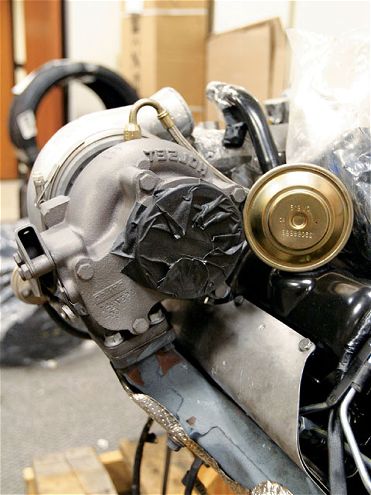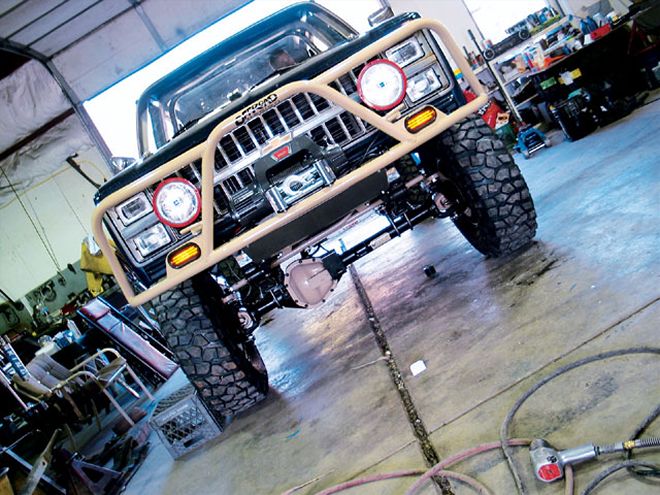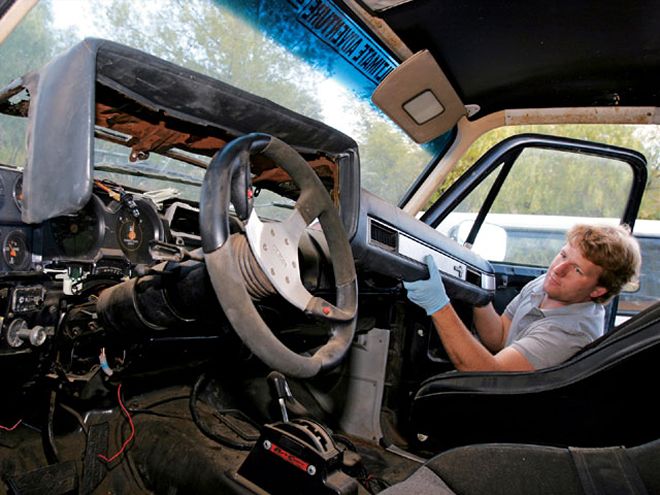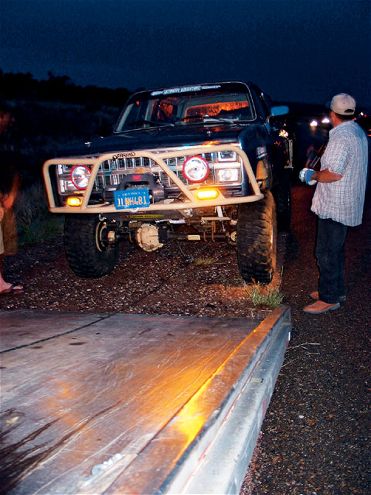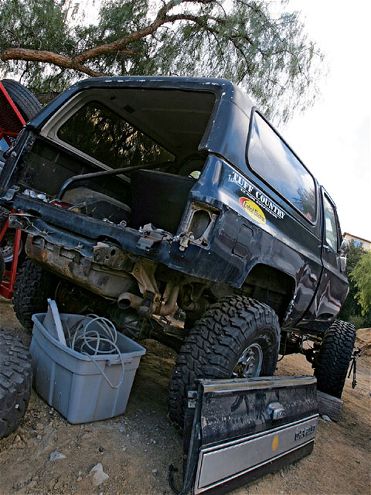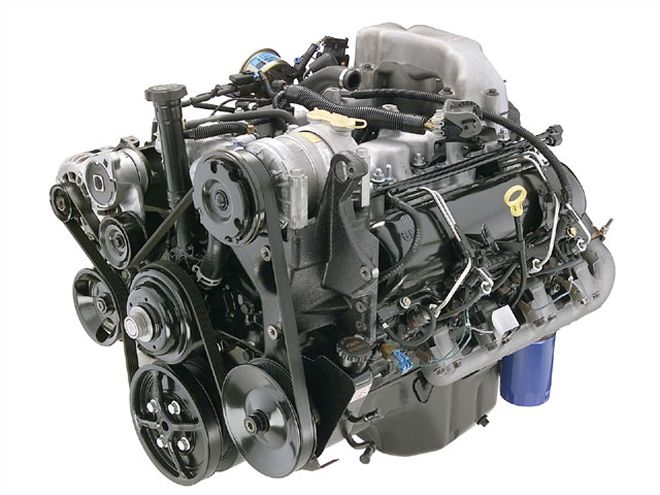
| Life for the 6.5L continues beyond General Motors' creation of the Duramax. In its final GM version, the 6.5L made 215 hp and 440 lb-ft of torque with a rear-mounted turbocharger. Over the next year, we're going to see if those numbers can be pushed up into Duramax territory without giving up simplicity or reliability.
General Motors has always enjoyed an impressive array of engines in its powertrain collection. With few exceptions, no matter what you thought of the rest of the vehicle, the powerplant under the hood of a Chevy or GMC truck has always been able to compete with the best anyone had to offer. Except, as some of you will now point out, its first attempt at a light-duty diesel engine: the 6.2L V-8.
Originally designed with the help of Detroit Diesel (which, at the time, was still part of GM), the 6.2L and, later, the 6.5L engines weren't intended to be the powerhouses one might expect from GM. Keep in mind that when these engines were originally conceived in the late 1970s, fuel economy was all the rage. The 6.2L diesel hit the market as a high-mpg alternative to the V-8 gas engine lineup at a time when 130 hp wasn't all that bad.
Rather than try to convince you the 6.2 and 6.5L diesels are better than you remember (we just might do that too), we're going to lay out the case for why the modern 6.5L is an ideal diesel-engine swap candidate for any vehicle that you want diesel powered. Or, as in the case with our
'82 K5 Blazer, re-powered. In this first of many installments, we'll reintroduce you to the Duramax's older brother and compare the 6.5L to some of the other diesels people talk about swapping.
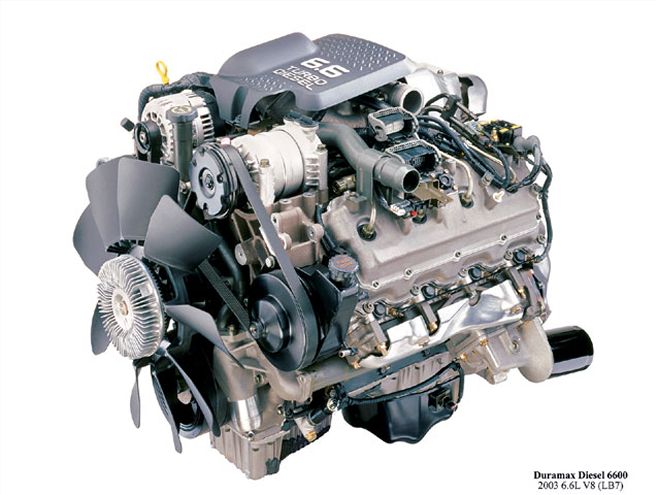
| While no one would ever confuse the Duramax for the 6.5L, you can certainly see the family resemblance between the two. The cylinder bore (4.06-inch) is the same, the oil filler tube is in the same location, the A/C compressor and power-steering pump are still on the driver side of the engine, and even the engine's main electrical connectors are carried over from the 6.5L.
GENERAL MOTORS DIESEL ENGINE SPECIFICATIONS 6.2L vs. 6.5L vs. 6.6L Duramax Engine codes: LH6, LL4 L56, L57,L65 LB7, LLY, LBZ, LMM
Year introduced: 1982 1992 2001
Displacement: 379 ci 397 ci 403 ci
Bore x stroke (in.): 3.98 x 3.{{{80}}} 4.06 x 3.82 4.06 x 3.{{{90}}}
Block material: cast iron cast iron cast iron
Head material: cast iron cast iron cast aluminum
Aspiration: normal turbo fixed or variable turbo
Valvetrain: OHV 2-V OHV 2-V OHV 4-V
Compression ratio: 21.5:1 18.0-20.2:1 17.5-16.4:1
Fuel injection: indirect indirect direct-injection, high-pressure common rail
Horsepower (intro): 130 hp @ 3,{{{600}}} rpm 190 hp @ 3,400 rpm {{{300}}} hp @ 3,{{{100}}} rpm
Torque (intro): {{{240}}} lb-ft @ 2,000 rpm 380 lb-ft @ 1,700 rpm 520 lb-ft @ 1,800 rpm
Horsepower (max): 143 hp @ 3,600 rpm 215 hp @ 3,{{{200}}} rpm 365 hp @ 3,200 rpm
Torque (max): 257 lb-ft @ 2,000 rpm 440 lb-ft @ 1,800 rpm 660 lb-ft @ 1,600 rpm
Max rpm: 3,600 rpm 3,400 rpm 3,450 rpm
Common 6.2/6.5L ProblemsThe 6.2 and 6.5L engines weren't without fault. Over the years, the GM design has been plagued with start-up and overheating issues more than true durability problems. Many of the troubles you read about online can be traced back to the emissions-control systems: glow-plug controller, injection-pump controller, or EGR. Remember, these engines were certified by GM for use in 11/42-, 31/44-, and 1-ton trucks (even in California), so there was a lot of emissions equipment found on these engines that didn't make it onto the Cummins and Power Strokes until just recently. That also means that 6.2 and 6.5Ls in 1-ton trucks and Hummers are likely to be more reliable because they have less emissions hardware.
However, there are a few areas that we'd keep an eye out for with any 6.2 or 6.5L. Because these engines use an indirect-injection they need larger cooling systems than other gasoline or diesel engines. Cooling wasn't a huge problem in the early 6.2L days, but as the power ratings increased and the new '88-'98 body style came to market, overheating seemed to become more common.
Here's what we'd watch out for:*Coolant leaks: Caused by external hoses and head-gasket failure, especially on '88-'96 trucks.
*Oil leaks: Oil pan design and early rear main seal are likely problems.
*Hard starting: Glow plugs prone to failure due to malfunctioning glow-plug controller. High compression ratios and the starter solenoid design only added to the problem.
*Excessive engine vibration: Due to harmonic balancer separating, which leads to crankshaft failure.
*Cylinder-head cracking: Due to overheating or poor casting quality.
*Engine-block failure: Due to insufficient casting quality, '00-and-later blocks are best.
*Electronic-injection-pump failure: Caused by overheated pump-mounted driver (PMD) and not a failed injection pump.
The New AM General Optimizer 6.5LGeneral Motors no longer builds the 6.5L diesel. General Engine Products (GEP), a division of AM General (yup, those guys that build the Hummer), produces what it calls the Optimizer 6500 engine in its Franklin, Ohio, assembly plant; General Engine Product's engine facility went into operation in July 2000. Before that, the 6.5L was built by General Motors at its Moraine Engine Plant. With GM's technical support, GEP developed the new facility and made numerous improvements to the engine. Today, the Optimizer 6500 engine is found in new military HMMWVs, H1s, and as a service replacement engine for GM 6.2 and 6.5Ls.
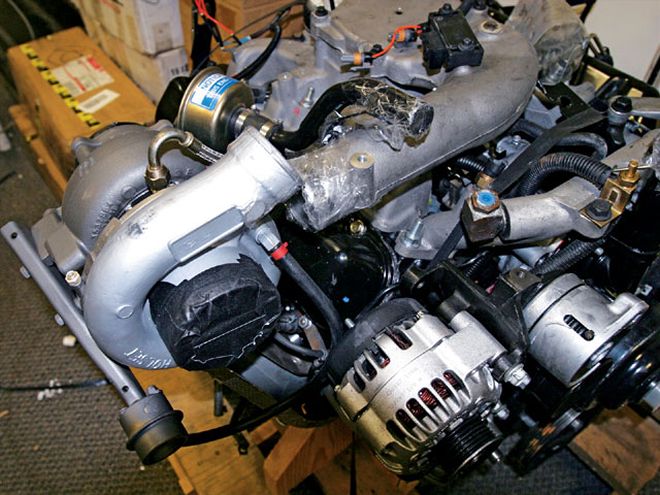
| Our plan is to fit an AFE open-element air cleaner to the turbo inlet. But as you can see, the turbo isn't going to hook up to the intake manifold the way we have it now. We'll solve that problem when we install a Turbonetics intercooler kit for GM 6.5L truck applications to reduce intake air temperatures.
Why Swap in the 6.2/6.5L?Often in life what's "popular" and what's "cool" aren't always the same thing. Since the 6.6L Duramax hit the scene in 2000, the 6.5L has lost appeal with enthusiasts who are in search of the ultimate in diesel power. To be honest, if a 500hp diesel is what you're after, the 6.5L isn't the engine for you. But if you're interested in swapping a diesel into your truck, car, or boat for fuel economy and simplicity, there isn't another diesel on the planet that will be as easy a conversion as the 6.5L transplant.
The key to the 6.5L swap is that its overall size and shape were largely dictated by the Chevy 350 and 454 gas engines that GM produced. While it shares almost nothing with those two engines, dimensionally it's very similar. Because of this family resemblance, the 6.5L is easily swapped in place of a Chevy V-8. And let's face it, the small-block Chevy is the world's most popular engine swap. So the 6.2 and 6.5L are readily adaptable to dozens of vehicles by simply using commonly available motor mounts, bellhousings, and conversion pieces for Chevy V-8s. Need more convincing? Let's compare the 6.5L to the Duramax and 5.9L Cummins engines.
6.6L DuramaxDonor vehicles: '01-present GM 3/4- and 1-ton pickups, '06-present GM vans, '06 HUMMER H1 Alpha, and GM medium-duty trucks.
Engine bellhousing pattern: Standard 90-degree Chevy V-8.
Engine mounts: Unique to '01-and-later GM trucks.
Size: Taller, wider, and heavier than 6.5L. Weighs about 860 pounds.
Electrical complexity: Significant. Duramax swaps almost always require a complete donor vehicle in order to swap over the engine, transmission, dashboard, vehicle computers, and wiring harness.
Cost of a usable engine on eBay at press time: $4,500 (long-block) to $10,500 (used engine, transmission, and all computers).
5.9L CumminsDonor vehicles: '89-present Dodge 3/4- and 1-ton pickups, Ford F-650 cab and chassis trucks, various Freightliner medium-duty trucks, various Case construction equipment, numerous boat, motor home, and school bus applications.
Engine bellhousing pattern: Varies. Can be adapted to 90-degree Chevy V-8 with Cummins parts.
Engine mounts: Unique to Cummins B series engine.
Size: Taller, longer, and heavier than 6.5L. Weighs about 1,100 pounds.
Electrical complexity: Varies. The '89-'98 engines are the most basic. The '03 would be the least complex common-rail engine swap.Cost of a usable engine on eBay at press time: $3,500 (12-valve long-block, no turbo) to $9,650 (24-valve with VP44 injection pump rebuilt drop in engine).
6.2/6.5LDonor vehicles: '82-'98 GM 1/2-, 3/4-, and 1-ton pickups, SUVs, vans, and Hummers.Engine bellhousing pattern:Standard 90-degree Chevy V-8.
Engine mounts: Traditional Chevy small-block. Can be adapted to fit many engine compartments with aftermarket pieces designed for small-block Chevy swaps.Size: Approximately the size of a Chevy big-block. Weighs about 700 pounds.
Electrical complexity: Varies. The mechanical-injected 6.2Ls are the most basic. The electronically controlled 6.5Ls have a computer-controlled injection system. Cost of a usable engine on eBay at press time: $2,700 (rebuilt 6.2L long-block) to $5,895 (6.5L with side-mounted turbo, rebuilt drop-in engine).
Original 6.2/6.5L ApplicationsChevrolet and GMC '82-'98 Pickups (up to '02 in 3500 HD cab and chassis)
'82-'98 Suburbans
'82-'98 Blazers/Jimmys/Tahoes/Yukons
'82-'02 Vans
'83-present Hummers/HMMWVs
6.2 / 6.5L Swap Advantages
Low weight Will fit anywhere a small- or big-block Chevy V-8 goesHigh rpm capability, 3,600 rpm redlineRepair-part costs are low and availability is highDonor engines are less expensive than Cummins, Duramax, or Power StrokeOnly diesel offered in a 1/2-ton pickup or SUVCan be configured to run naturally aspirated, turbocharged, or intercooled
Possible 6.2 and 6.5L Swaps Candidates'00-and-earlier model year rear-wheel-drive GM trucks or cars that came with gas V-8sApplications where fuel economy and/or diesel emissions compatibility is importantJeep Grand Wagoneers and Cherokees (fullsize)Toyota Land Cruiser (fullsize)Jeep Wranglers or older CJs'80s Land Rovers or Range Rovers with Buick V-8sSpecialty construction vehicles, "kit cars," that require a dieselInboard engine boats that can package a GM V-8
Fuel EconomyThe 6.2 and 6.5L engines were intended first and foremost for fuel economy. According to the U.S. Department of Energy (www.fueleconomy.gov), an '85 Chevrolet two-wheel-drive 1/2-ton pickup equipped with a manual transmission and a 6.2L diesel was rated at 20 mpg city and 23 mpg highway. That meant it got better fuel economy than the 5.0, 5.7L, 7.4L gasoline V-8s-and even the 4.3L V-6 engines!
As the diesel power wars heated up in the early 1990s, General Motors needed to be competitive with the larger Ford 7.3L and the turbocharged 5.9L Dodge Cummins offerings. Diesel fuel economy took a back seat to horsepower. The 6.2 and, later, the 6.5L power levels were raised accordingly. Output peaked at just over 200 hp and approached 450 lb-ft of torque. Fearing the 6.5L indirect-injection architecture wouldn't be enough to claim best in class performance (along with the promise of new diesel technologies) eventually led GM to pursue a clean-sheet, direct-injection, common-rail diesel design that we know today as the Duramax.
 | Life for the 6.5L continues beyond General Motors' creation of the Duramax. In its final GM version, the 6.5L made 215 hp and 440 lb-ft of torque with a rear-mounted turbocharger. Over the next year, we're going to see if those numbers can be pushed up into Duramax territory without giving up simplicity or reliability.
General Motors has always enjoyed an impressive array of engines in its powertrain collection. With few exceptions, no matter what you thought of the rest of the vehicle, the powerplant under the hood of a Chevy or GMC truck has always been able to compete with the best anyone had to offer. Except, as some of you will now point out, its first attempt at a light-duty diesel engine: the 6.2L V-8.
Originally designed with the help of Detroit Diesel (which, at the time, was still part of GM), the 6.2L and, later, the 6.5L engines weren't intended to be the powerhouses one might expect from GM. Keep in mind that when these engines were originally conceived in the late 1970s, fuel economy was all the rage. The 6.2L diesel hit the market as a high-mpg alternative to the V-8 gas engine lineup at a time when 130 hp wasn't all that bad.
Rather than try to convince you the 6.2 and 6.5L diesels are better than you remember (we just might do that too), we're going to lay out the case for why the modern 6.5L is an ideal diesel-engine swap candidate for any vehicle that you want diesel powered. Or, as in the case with our '82 K5 Blazer, re-powered. In this first of many installments, we'll reintroduce you to the Duramax's older brother and compare the 6.5L to some of the other diesels people talk about swapping.
| Life for the 6.5L continues beyond General Motors' creation of the Duramax. In its final GM version, the 6.5L made 215 hp and 440 lb-ft of torque with a rear-mounted turbocharger. Over the next year, we're going to see if those numbers can be pushed up into Duramax territory without giving up simplicity or reliability.
General Motors has always enjoyed an impressive array of engines in its powertrain collection. With few exceptions, no matter what you thought of the rest of the vehicle, the powerplant under the hood of a Chevy or GMC truck has always been able to compete with the best anyone had to offer. Except, as some of you will now point out, its first attempt at a light-duty diesel engine: the 6.2L V-8.
Originally designed with the help of Detroit Diesel (which, at the time, was still part of GM), the 6.2L and, later, the 6.5L engines weren't intended to be the powerhouses one might expect from GM. Keep in mind that when these engines were originally conceived in the late 1970s, fuel economy was all the rage. The 6.2L diesel hit the market as a high-mpg alternative to the V-8 gas engine lineup at a time when 130 hp wasn't all that bad.
Rather than try to convince you the 6.2 and 6.5L diesels are better than you remember (we just might do that too), we're going to lay out the case for why the modern 6.5L is an ideal diesel-engine swap candidate for any vehicle that you want diesel powered. Or, as in the case with our '82 K5 Blazer, re-powered. In this first of many installments, we'll reintroduce you to the Duramax's older brother and compare the 6.5L to some of the other diesels people talk about swapping.
 | While no one would ever confuse the Duramax for the 6.5L, you can certainly see the family resemblance between the two. The cylinder bore (4.06-inch) is the same, the oil filler tube is in the same location, the A/C compressor and power-steering pump are still on the driver side of the engine, and even the engine's main electrical connectors are carried over from the 6.5L.
GENERAL MOTORS DIESEL ENGINE SPECIFICATIONS 6.2L vs. 6.5L vs. 6.6L Duramax Engine codes: LH6, LL4 L56, L57,L65 LB7, LLY, LBZ, LMM Year introduced: 1982 1992 2001 Displacement: 379 ci 397 ci 403 ci Bore x stroke (in.): 3.98 x 3.{{{80}}} 4.06 x 3.82 4.06 x 3.{{{90}}} Block material: cast iron cast iron cast iron Head material: cast iron cast iron cast aluminum Aspiration: normal turbo fixed or variable turbo Valvetrain: OHV 2-V OHV 2-V OHV 4-V Compression ratio: 21.5:1 18.0-20.2:1 17.5-16.4:1 Fuel injection: indirect indirect direct-injection, high-pressure common rail Horsepower (intro): 130 hp @ 3,{{{600}}} rpm 190 hp @ 3,400 rpm {{{300}}} hp @ 3,{{{100}}} rpm Torque (intro): {{{240}}} lb-ft @ 2,000 rpm 380 lb-ft @ 1,700 rpm 520 lb-ft @ 1,800 rpm Horsepower (max): 143 hp @ 3,600 rpm 215 hp @ 3,{{{200}}} rpm 365 hp @ 3,200 rpm Torque (max): 257 lb-ft @ 2,000 rpm 440 lb-ft @ 1,800 rpm 660 lb-ft @ 1,600 rpm Max rpm: 3,600 rpm 3,400 rpm 3,450 rpm
| While no one would ever confuse the Duramax for the 6.5L, you can certainly see the family resemblance between the two. The cylinder bore (4.06-inch) is the same, the oil filler tube is in the same location, the A/C compressor and power-steering pump are still on the driver side of the engine, and even the engine's main electrical connectors are carried over from the 6.5L.
GENERAL MOTORS DIESEL ENGINE SPECIFICATIONS 6.2L vs. 6.5L vs. 6.6L Duramax Engine codes: LH6, LL4 L56, L57,L65 LB7, LLY, LBZ, LMM Year introduced: 1982 1992 2001 Displacement: 379 ci 397 ci 403 ci Bore x stroke (in.): 3.98 x 3.{{{80}}} 4.06 x 3.82 4.06 x 3.{{{90}}} Block material: cast iron cast iron cast iron Head material: cast iron cast iron cast aluminum Aspiration: normal turbo fixed or variable turbo Valvetrain: OHV 2-V OHV 2-V OHV 4-V Compression ratio: 21.5:1 18.0-20.2:1 17.5-16.4:1 Fuel injection: indirect indirect direct-injection, high-pressure common rail Horsepower (intro): 130 hp @ 3,{{{600}}} rpm 190 hp @ 3,400 rpm {{{300}}} hp @ 3,{{{100}}} rpm Torque (intro): {{{240}}} lb-ft @ 2,000 rpm 380 lb-ft @ 1,700 rpm 520 lb-ft @ 1,800 rpm Horsepower (max): 143 hp @ 3,600 rpm 215 hp @ 3,{{{200}}} rpm 365 hp @ 3,200 rpm Torque (max): 257 lb-ft @ 2,000 rpm 440 lb-ft @ 1,800 rpm 660 lb-ft @ 1,600 rpm Max rpm: 3,600 rpm 3,400 rpm 3,450 rpm
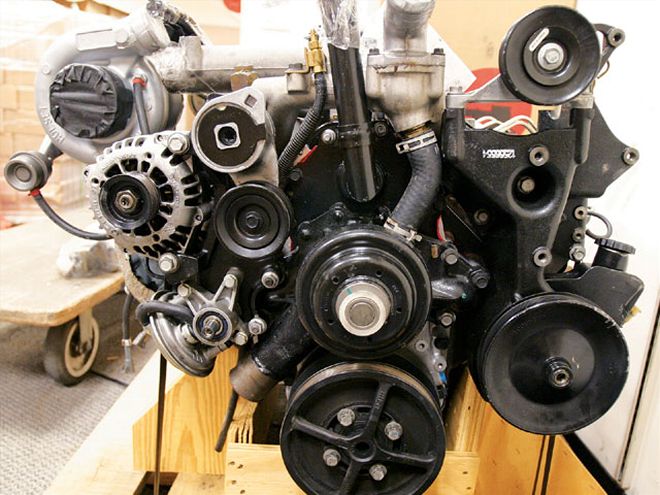
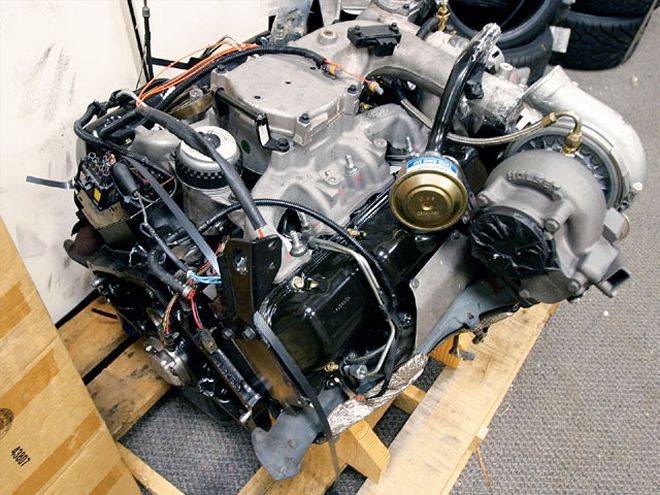
 | Our plan is to fit an AFE open-element air cleaner to the turbo inlet. But as you can see, the turbo isn't going to hook up to the intake manifold the way we have it now. We'll solve that problem when we install a Turbonetics intercooler kit for GM 6.5L truck applications to reduce intake air temperatures.
Why Swap in the 6.2/6.5L?
| Our plan is to fit an AFE open-element air cleaner to the turbo inlet. But as you can see, the turbo isn't going to hook up to the intake manifold the way we have it now. We'll solve that problem when we install a Turbonetics intercooler kit for GM 6.5L truck applications to reduce intake air temperatures.
Why Swap in the 6.2/6.5L?